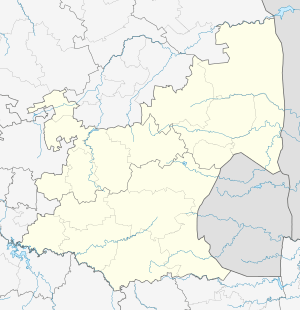Kaapsehoop
Kaapsehoop or Kaapschehoop is a town in the Mpumalanga province (formerly Eastern Transvaal) of South Africa. It is situated 1486 m (4878 ft.) above sea level on the Highveld escarpment, about 25 km from Nelspruit, the capital of Mpumalanga. The name of the town is no doubt derived from the fact that when gold was discovered in the town, the find created hope for the early inhabitants of the geographically nearby De Kaap Valley – The Cape Valley – of attaining great wealth.
Kaapsehoop | |
|---|---|
Rock fields near the town of Kaapsche Hoop | |
 Kaapsehoop  Kaapsehoop | |
| Coordinates: 25°35′S 30°46′E | |
| Country | South Africa |
| Province | Mpumalanga |
| District | Ehlanzeni |
| Municipality | Mbombela |
| Area | |
| • Total | 0.35 km2 (0.14 sq mi) |
| Population (2011)[1] | |
| • Total | 182 |
| • Density | 520/km2 (1,300/sq mi) |
| Racial makeup (2011) | |
| • Black African | 24.7% |
| • White | 75.3% |
| First languages (2011) | |
| • Afrikaans | 51.1% |
| • English | 25.0% |
| • Swazi | 20.0% |
| • Southern Ndebele | 1.1% |
| • Other | 2.8% |
| Time zone | UTC+2 (SAST) |
Kaapsehoop is set out between large natural clearings in the rock fields near the top of the escarpment overlooking the lush De Kaap Valley situated some 800 metres below, with distant views towards Barberton and Nelspruit.
History
 Entrance to Kaasche Hoop
Entrance to Kaasche Hoop- Kaapsche Hoop streetscape
 Mining Commissioner's House 1884 Kaapsche Hoop
Mining Commissioner's House 1884 Kaapsche Hoop
Kaapsehoop originally gained fame as a gold mining town once known as the Duiwels Kantoor – the Devil's Office – towards the end of the 19th century, when gold was discovered in 1882 in a small creek running through the town. This led to portion of the original township layout being canceled and opened up for gold diggings. However, the earlier better paying discoveries of gold at both Pilgrim's Rest in 1873 and Barberton in 1881, followed by the discovery of gold on the Witwatersrand in 1886 (later to become the town of Johannesburg), coupled with the meager returns obtained at Kaapsche Hoop led to the town going into decline.
 Edge of escarpment overlooking De Kaap valley
Edge of escarpment overlooking De Kaap valley The Kaapsehoop heights seen from below
The Kaapsehoop heights seen from below- Old Surveyor General Map of Kaapsche Hoop showing diggings area crossed out
The town has been "re-discovered" in recent time and has now become a popular weekend retreat with its period housing including accommodation establishments. New housing (some not period) has also been established on some of the remaining vacant stands (erven). The town is also within commuting distance of the centre of Nelspruit situated some 30 odd kilometres away.
The rock field formations near the town are made up of quartzites of the Black Reef Formation of the Transvaal Supergroup.
Origin of the name
Kaapsche Hoop is the original High Dutch spelling of Kaapsehoop as now spelt in Afrikaans. The name of the town was no doubt derived from the fact that gold was discovered in the town which sits high above the De Kaap Valley – The Cape Valley – and the find then created the hope for the early inhabitants of the nearby De Kaap Valley area of attaining great wealth.
High Dutch was the official language of the two original Boer Republics of the Orange Free State or Oranje-Vrijstaat and the South African Republic or Suid Afrikaanse Republiek or Zuid-Afrikaansche Republiek (ZAR). High Dutch was eventually to be replaced by Afrikaans a colloquially spoken language of many of the European descended settlers. Afrikaans was largely derived from Dutch and incorporating words derived or adopted from French, German, English and indigenous African languages. (Refer to main page of Afrikaans to learn more).
References
- "Sub Place Kaapsehoop". Census 2011.
.svg.png)